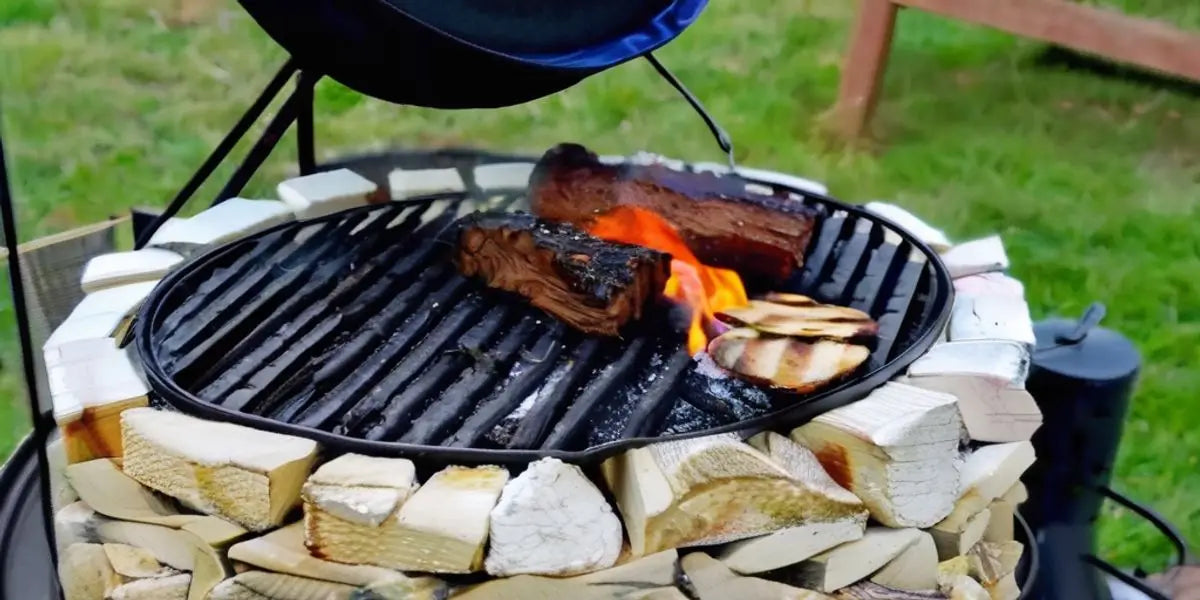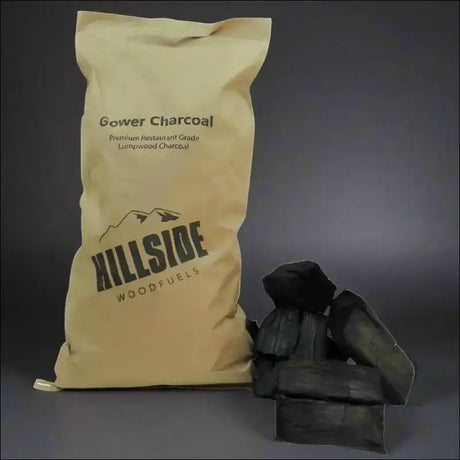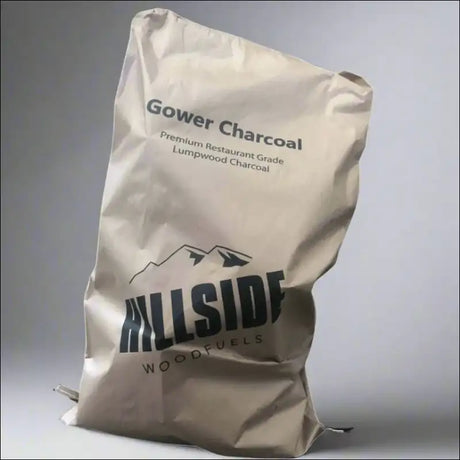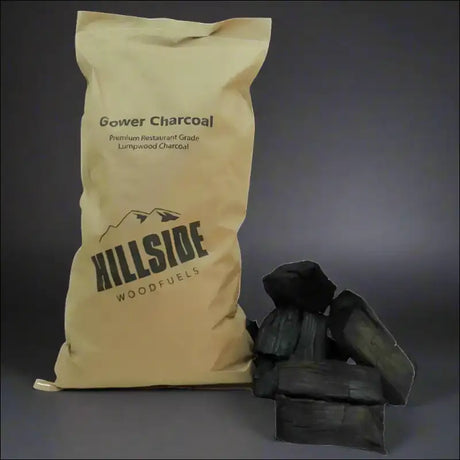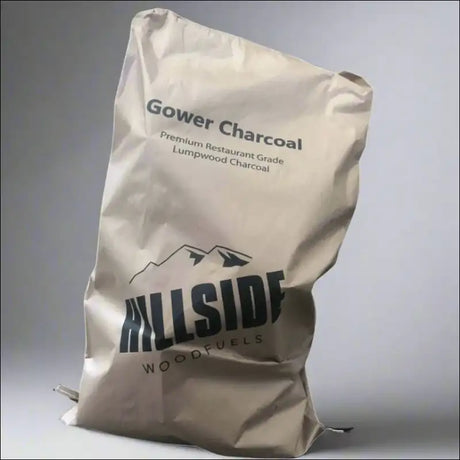Mastering the Art of Lump Charcoal Lighting

Choosing Your Lighting Method
When you're ready to dive into the world of live fire cooking, selecting the right lighting method for your lump charcoal is crucial. You have several options at your disposal, each with its own merits. For instance, an electric lighter offers convenience and speed, while a chimney starter, favored by chefs like Katsuji Tanabe, provides a more traditional approach using paper and vegetable oil. Here's a quick guide to help you choose:
- Electric Lighters: Fast and convenient, ideal for quick starts.
- Chimney Starters: Reliable and easy, uses natural materials like paper.
- Roofing Torches: Intense heat, good for larger quantities.
- Direct Lighting: Build a small fire with tinder and kindling, for the purists.
Remember, patience is key. Allow the charcoal to ignite fully and reach the perfect temperature before you start cooking. This ensures your food will cook evenly and acquire that authentic BBQ flavor that lumpwood charcoal is celebrated for worldwide.
Safety should always be your top priority. Ensure your grill is clean and positioned away from flammable materials. Control the temperature using vents and avoid using lighter fluids, which can impart unwanted flavors to your food.
Safety Tips for Sparking and Popping
When you're ready to master the art of charcoal grilling, understanding how to safely light lump charcoal is crucial. Sparking and popping are common when lighting charcoal, but with a few precautions, you can minimize the risks and ensure a safe grilling experience.
Firstly, always light your charcoal in a well-ventilated area to avoid inhaling excessive smoke. If you're using lighter fluid, allow it to soak into the charcoal for three to four minutes before igniting. This ensures that the fluid penetrates the charcoal and doesn't just burn off the surface.
Remember, patience is key. Rushing the lighting process can lead to unpredictable flare-ups and increased sparking.
Here's a quick checklist to keep in mind:
- Use a chimney starter or electric starter for a cleaner and safer lighting method.
- Keep a safe distance while lighting and wait for the initial sparking to subside.
- Have a spray bottle of water handy to tame any unexpected flare-ups.
- Avoid using lighter fluid if possible, as it can lead to more intense sparking and affect the taste of your food.
By following these tips, you'll not only prevent accidents but also ensure that your charcoal burns evenly, setting the stage for a triumphant barbecue experience.
Achieving the Perfect Ember
Once you've chosen your lighting method and taken the necessary safety precautions, your next step is to achieve the perfect ember. This is the heart of live fire cooking, where the temperature and quality of your charcoal can make or break your culinary masterpiece. Start by arranging your lump charcoal in a pyramid shape to maximize airflow and encourage even burning.
- Light the charcoal and wait for it to be covered with a thin layer of white ash. This indicates that the charcoal is ready for cooking.
- Spread the charcoal evenly across the grill to create a consistent cooking surface.
- Adjust the distance between the food and the charcoal to control the cooking temperature.
Remember, patience is key. Rushing the process can lead to uneven cooking and a less desirable flavor profile. Allow the charcoal to reach its full potential before you begin grilling.
By following these steps, you'll master the art of live fire cooking with premium charcoal for smoky sides and juicy meats. Proper storage, lighting, and cooking techniques ensure restaurant-worthy results. Go low and slow for maximum flavor infusion.
The Flavor Profile of Lump Charcoal

Comparing Lump Charcoal and Briquettes
When you're gearing up for a grilling session, the choice between lump charcoal and briquettes can make all the difference in your culinary experience. Lump charcoal, known for its ability to get extremely hot, offers a pure wood flavor without the additives found in briquettes. However, it's important to note that lump charcoal can be more challenging to light and maintain due to the irregular sizes and shapes of the wood chunks.
On the other hand, briquettes provide a more consistent burn due to their uniform shape and size, but they come with a trade-off. The binders and fillers used in briquettes can impart a distinct smoky flavor to your food, which some find desirable while others may not. Additionally, briquettes tend to produce more ash and don't reach the high temperatures that lump charcoal can.
When selecting your grilling fuel, consider the impact on taste, heat output, and burn time to achieve the best results for your dish.
Here's a quick comparison to help you weigh your options:
- Lump Charcoal: Pure wood chunks, hotter burn, less ash, more challenging to light.
- Briquettes: Consistent shape, longer burn time, distinctive smoky flavor, more ash production.
The Impact of Charcoal on Food Taste
When you're planning your next BBQ, the choice of charcoal can make a significant difference in the taste of your food. Lump charcoal, known for its ability to burn hot and clean, is a favorite among grilling enthusiasts for its minimal impact on flavor. This allows the natural taste of your meat or vegetables to shine through.
- Oak Charcoal: Bold, smoky flavor.
- Hickory Charcoal: Strong, distinctive taste.
- Lumpwood Charcoal: Neutral, lets the food's flavors prevail.
Consider the type of food you're grilling and the flavor profile you desire. For a more pronounced smoky taste, you might opt for oak or hickory. If you prefer your food to speak for itself, lumpwood charcoal is your go-to.
The right charcoal can elevate your culinary creations, turning a simple meal into an unforgettable experience. Remember, the subtle nuances of charcoal can either complement or overpower your dish, so choose wisely.
When selecting charcoal, take into account not only the flavor but also the burn time and ash production. A charcoal that burns clean and produces little ash, like The Good Charcoal, ensures a smoother cooking process and easier cleanup.
Selecting the Right Charcoal for Your Dish
When you're aiming for culinary excellence, the choice of charcoal can make all the difference. Restaurant grade lumpwood charcoal is renowned for its superior quality and ability to impart a distinct flavor to your dishes. Here's how to select the right charcoal for your culinary adventures:
- Flavor: Consider the type of wood the charcoal is made from. Different woods like oak, hickory, or fruitwoods offer unique flavors that can complement your dish.
- Burn Time: High-quality lump charcoal tends to burn longer and more consistently, providing a steady heat source for your cooking.
- Smoke Production: Some charcoals produce more smoke than others, which can add a smoky essence to your food.
When considering the right charcoal, think about the flavor profile you desire. The top producers of gourmet lump charcoals from UK, Mexico, USA, and Indonesia offer a variety of options. Use unique flavors like hickory and fruit woods for cooking variety. Mix and layer charcoals for signature tastes.
Remember, the size of your grill also plays a role in the amount and type of charcoal you'll need. Larger grills require more fuel, so plan accordingly to maintain the desired temperature throughout the cooking process.
Combining Lump Charcoal with Briquettes

Benefits of Mixing Charcoal Types
When you're at the helm of your grill, the choice between lumpwood charcoal and briquettes can make all the difference in your culinary adventure. Lumpwood charcoal, known for its quick heating and distinct smoky flavor, pairs wonderfully with the consistent burn and ease of use offered by briquettes. By combining the two, you can tailor your grilling experience to suit your preferences and the specific needs of the dish you're preparing.
Embrace the synergy of lumpwood and briquettes to elevate your grilling game. The blend allows you to harness the best of both worlds: the robust flavor from lumpwood and the predictable burn time of briquettes.
Here's why you might consider mixing them:
- Lumpwood charcoal can reach high temperatures, perfect for searing.
- Briquettes offer a steady, manageable heat for extended cooking.
- The mix can reduce the overall cost, as lumpwood can be more expensive.
- You can achieve a balance in flavor intensity and heat control.
Remember, the art of grilling is as much about the process as it is about the outcome. Experiment with different ratios to find your perfect match and create unforgettable meals that are a true reflection of your grilling prowess.
How to Blend for Optimal Flavor
Blending lump charcoal with briquettes is akin to becoming a maestro of the grill, orchestrating a symphony of flavors and temperatures. Start by understanding the characteristics of your lump charcoal. Each type of wood imparts a unique flavor profile, so consider the taste you're aiming for in your dish.
- Step 1: Begin with a base of lump charcoal for a quick, hot fire and pure flavor.
- Step 2: Add briquettes to extend the burn time and stabilize the temperature.
- Step 3: Adjust the ratio according to your cooking needs; a higher proportion of lump charcoal for searing and a balanced mix for slow roasting.
Remember, the goal is to enhance the natural flavors of your food without overpowering them. Experiment with different blends to find the perfect match for your culinary creations.
When purchasing lumpwood charcoal, it's essential to verify the source and choose sustainable options. Know the wood type and inquire about the production process. By enhancing flavor with different wood types and managing heat and burn time, you'll achieve grilling mastery. Lumpwood is often preferred for its purity, flavor, and sustainability.
Understanding the Heat and Burn Time Dynamics
When you're selecting lump charcoal for your culinary adventures, understanding the heat and burn time dynamics is crucial. Lump charcoal is known for its ability to reach high temperatures quickly, providing that intense sear that can elevate your dishes. However, it's important to note that not all lump charcoals are created equal. Some are designed for longer burn times, ideal for extended cooking sessions, while others are tailored for a quick, hot burn, suitable for shorter grilling tasks.
The key to mastering live fire cooking is balancing the heat output with the desired cooking duration. This ensures your food is cooked to perfection without drying out or becoming overly charred.
Here's a simple guide to help you gauge the characteristics of your lump charcoal:
- Long-burning lump charcoal is best for low-and-slow cooking methods.
- Quick-burning lump charcoal is your go-to for fast grilling and searing.
- For extended cooking, consider reusing long-lived charcoal to maximize the value of your purchase.
Remember, the choice of charcoal will directly influence the flavor and moisture content of your food. So, take a moment to consider the burn time and heat dynamics before lighting up your grill.
The Economic and Environmental Advantages of Lump Charcoal

Cost-Effectiveness of Reusing Lump Charcoal
When you're firing up the grill, the choice of charcoal can make a significant difference not just in flavor, but also in your wallet's well-being. Lump charcoal, known for its pure wood composition and high-heat capabilities, is a premium choice for grilling enthusiasts. But did you know that its cost-effectiveness is one of its unsung virtues?
Unlike briquettes, lump charcoal can be reused. After your cookout, simply smother the fire by cutting off the oxygen supply. The remaining charcoal can be reignited for your next barbecue, stretching your dollar further. Here's how to ensure you get the most out of your lump charcoal:
- Ensure complete extinguishing of the charcoal by tightly closing the grill vents.
- Once cooled, store the remaining charcoal in a dry place to prevent moisture absorption.
- Sort through the charcoal before the next use, removing any ash or smaller, unusable pieces.
By reusing lump charcoal, you not only save money but also contribute to a more sustainable grilling practice, reducing waste and the need for frequent purchases.
Remember, while lump charcoal may carry a higher price tag initially, its reusability and the ability to provide a superior searing for quick barbecues make it a smart long-term investment. Embrace the economy of lump charcoal and enjoy the added benefits of airflow, heating speed, and that distinct smoky flavor that elevates your dishes.
Lump Charcoal: A Sustainable Choice?
When you're considering the sustainability of your grilling choices, lumpwood charcoal stands out for its eco-friendly credentials. Unlike briquettes, lump charcoal is crafted from pure wood chunks without any additives, ensuring a natural and cleaner burn. This means less ash to deal with post-barbecue, simplifying cleanup and reducing waste.
Embrace the sustainable side of grilling with lumpwood charcoal. Its ability to get extremely hot opens up a myriad of cooking possibilities, while its lower temperature endurance surpasses that of briquettes, offering a longer burn time for those extended cooking sessions.
However, it's important to note that lump charcoal's versatility comes with a price tag often higher than briquettes. But don't let this deter you; the investment pays off in the long run. Here's a quick comparison to guide you:
| Lump Charcoal | Briquettes |
|---|---|
| Pure wood chunks | Additives present |
| Higher heat potential | Easier to light |
| Less ash production | More ash residue |
| Reusable | Single-use |
Remember, the choice between lump charcoal and briquettes ultimately depends on your specific needs and values. If sustainability and a pure grilling experience are high on your list, lumpwood charcoal is the way to go.
Storage and Maintenance for Longevity
To ensure your lump charcoal remains ready for your next grilling adventure, proper storage and maintenance are key. Start by keeping your charcoal in a cool, dry place, away from any moisture that could potentially dampen its fiery spirit. A sealed container or a charcoal storage bag can prevent unwanted humidity from compromising the quality of your fuel.
When it comes to maintenance, remember that the longevity of lump charcoal is also influenced by how it's used. After grilling, allow the charcoal to cool completely before handling. Then, sift through the ashes to separate unburned pieces which can be reused. This not only saves money but also contributes to a more sustainable grilling practice.
By reusing unburned lump charcoal, you're not just being economical; you're also reducing waste and embracing an eco-friendly approach to live fire cooking.
Lastly, inspect your grill regularly for ash buildup. A clean grill ensures better airflow and temperature control, which are crucial for the perfect cook. Follow these simple steps, and you'll be rewarded with a reliable, eco-friendly, and flavorful grilling experience.
Advanced Techniques in Live Fire Cooking

Harnessing Infrared Heat for Even Cooking
When you're aiming for that perfect sear without overcooking, infrared heat is your secret weapon. Unlike direct flame, infrared heat penetrates your food, cooking it evenly from the inside out. This method is especially effective for quick-cooking items that benefit from a high-heat surface without the prolonged exposure that can dry out your meal.
To get started, you'll want to select a high-quality lump charcoal known for its ability to generate infrared heat. Products like the Jealous Devil Onyx Binchotan Charcoal are renowned for their intense far infrared heat, ideal for achieving that restaurant-quality crust on your steaks or vegetables.
Remember, while infrared heat is fantastic for quick cooks, it's less suited for dishes that require long, slow cooking times. The dry nature of this heat can rob your food of moisture, so it's best used in conjunction with other cooking methods for those slow-roasted recipes.
Here's a simple guide to help you harness the power of infrared heat:
- Choose a lump charcoal that specifies it can produce infrared heat.
- Light your charcoal and allow it to reach the optimal temperature for infrared cooking.
- Place your food directly above the heat source to sear and cook evenly.
- Monitor closely to prevent overcooking, as the intense heat can cook food quickly.
By following these steps, you'll ensure your dishes are cooked to perfection with the unique benefits that only lump charcoal can provide.
Tips for Low-and-Slow Cooking with Lump Charcoal
When you're ready to embrace the art of low-and-slow cooking, lump charcoal is your ally. This method requires patience and precision, but the reward is a succulent feast, infused with a subtle smokiness that only lump charcoal can provide. Here's how to ensure your slow-cooked dishes are a cut above the rest:
- Start with a clean grill: Residual ash can impede airflow and temperature control.
- Arrange the charcoal evenly: This promotes consistent heat for the long haul.
- Monitor the temperature: Aim for a steady range between 106-122C
Remember, low-and-slow is a marathon, not a sprint. Resist the urge to frequently check the food, as each peek can extend cooking time.
Understanding the nuances of your charcoal's performance is crucial. Lump charcoal can burn hotter and with less ash than briquettes, but it may also require more attention to maintain the ideal temperature. If you find the heat waning, add a few more pieces of charcoal to sustain the ember. And when the cooking is done, smother the fire to save any unused charcoal for your next culinary adventure.
Conclusion
In the dance of flames and the glow of embers, cooking with live fire and lump charcoal is an art that transcends mere culinary practice, becoming a romance with the primal elements. The tactile experience of lighting lump charcoal, the anticipation as it comes to temperature, and the mastery of harnessing its heat to imbue dishes with a smoky essence, all contribute to the allure of this traditional cooking method.
Frequently Asked Questions
How do you light lump charcoal?
Lighting lump charcoal can be done using electric lighters, roofing torches, or a chimney starter with paper and vegetable oil. A chimney starter is a popular choice for its reliability and ease.
Can you mix lump charcoal with briquettes?
Yes, you can mix lump charcoal with briquettes to achieve a balance of flavors and the nostalgia of traditional grilling methods.
What are the safety concerns when lighting lump charcoal?
Sparking and popping can pose safety issues when lighting lump charcoal. It's recommended to light it in a well-ventilated area and maintain a safe distance until the flames have settled.
What are the flavor differences between lump charcoal and briquettes?
Lump charcoal burns with a clean smoke and subtly flavors the food, whereas briquettes tend to be smokier and impart a stronger, distinctive taste due to binders and fillers.
Is lump charcoal reusable?
Yes, lump charcoal is reusable. By smothering the fire and cutting off oxygen, the remaining charcoal can be saved and used for the next grilling session.
How does lump charcoal affect the environment compared to briquettes?
Lump charcoal is often seen as a more sustainable option than briquettes, as it typically contains no added chemicals and produces less ash. However, the sourcing of the wood and production methods can also impact its environmental footprint.

